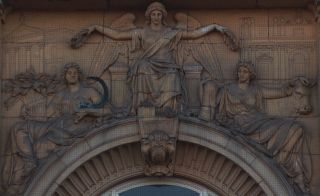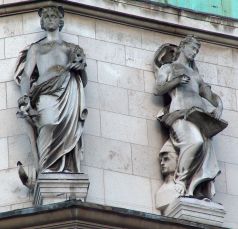 CH and J Mabey's Corn Exchange frieze.
CH and J Mabey's Corn Exchange frieze.
Doncaster is not particularly awash with statues from the Victorian period, but there are two buildings with architectural decoration that deserve noting.
The first is the Corn Exchange, an imposing stone building by the architect William Wilkins. Above the main entrance is a lunette, with above it a composition in stone showing two female figures seated on the curve of the lunette, and a central angel. Behind, in low relief, are depictions of the Doncaster Guildhall and Mansion House. The central angel looks straight forward and slightly downwards, her arms stretched out symmetrically, holding victory wreaths over the two flanking figures. The wings, too, are symmetrical, but the figure is given some variety by the drapery, and the raising up the one foot onto a small block. The figure to our left is emblematic of Agriculture, with a sickle and sheaf of corn; that on the right rests her arm on the head of a cow, and holds what appears to be a rolled up carpet. According to contemporary sources cited by PMSA, the sculptors were the firm of CH and J Mabey of Westminster, London.
 CH and J Mabey's Corn Exchange frieze.
CH and J Mabey's Corn Exchange frieze.
The second building bearing significant sculptural work is the HSBC bank building on the corner of High Street and Baxtergate, which was built for a smaller bank later incorporated into HSBC. At dormer level, there are four full-sized stone figures, in pairs, all female, and rather obscure. The lefternmost, semidraped and with a nice, sinuous pose, stands in front of pile of books with a globe on top, and holds against it what may be callipers – perhaps emblematic of Geography – though the books suggest something more complex, perhaps the spread of knowledge. Her companion, fully draped and carrying a cornucopia, is presumably Wealth or Commerce. The right side pair has firstly a semidraped figure whose anchor and little wings peeking from her hair – if this is what they are – suggestive of Maritime Travel or News. And to the right, the final figure carries a book, with a sculpted head behind her. Her other hand, raised, might once have held something else to help us see if she is the Arts or something else. The limestone of which they are made shows no remaining sign of any signature, so the maker is obscure too. Nevertheless, good work, particularly the rightmost figure, whose falling drapes show a nicely rounded form, and the ensemble is not atypical of a number of buildings in the less major cities and towns around the country adorned with stone figures. Atop the summit cupola is a Mercury in bronze.
 Two of the figures on the HSBC building.
Two of the figures on the HSBC building.
We may note a few other things in the town:
Sculpture pages // Statues in English towns
Visits to this page from 23 Nov 2011: 6,704